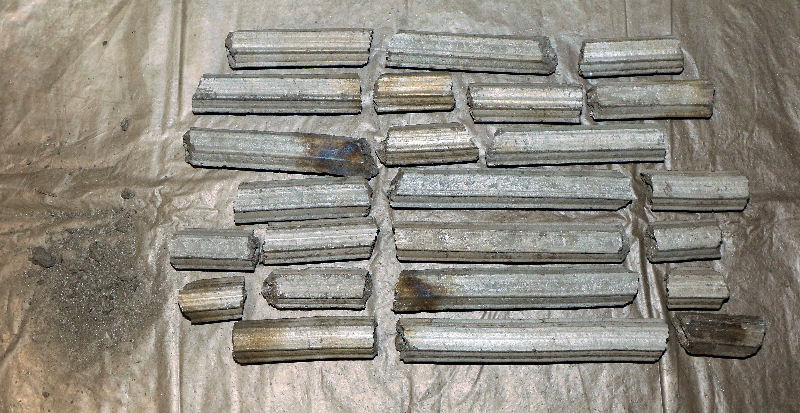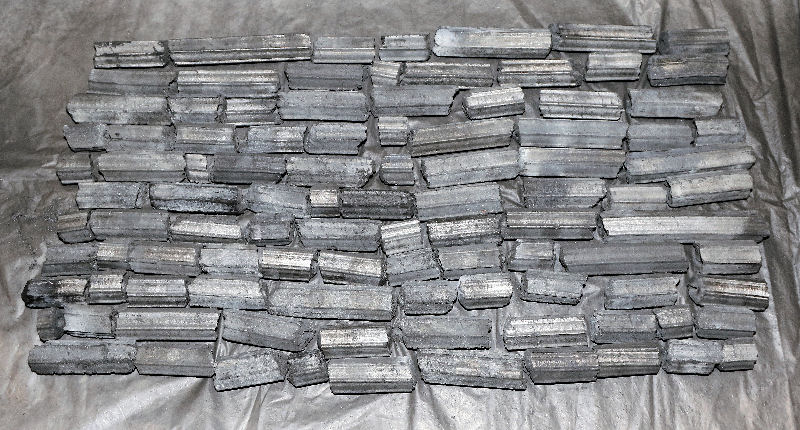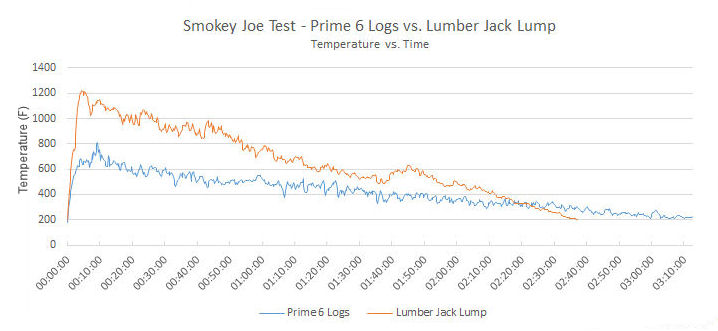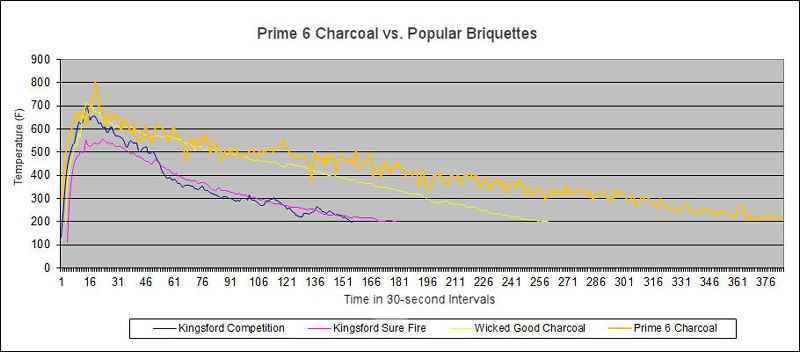 |
 |
Introduction In order to evaluate Prime 6 charcoal, we ran our usual set of tests so we could compare the results with our results from testing over 120 brands of lump charcoal and a number of brands of extruded charcoal. We also included an open grill "Smokey Joe" test to compare Prime 6 to both lump charcoal and briquettes when grilling on an open grill.
The Boxes
And here are a couple of photos of the 22-pound box.
The Extruded Logs
 The contents of the 22-pound box were similar. The box contained 100 grams of crumbs.
 The individual logs are approximately 1.5 inches across (flat side to flat side) with a hole down the center of the log which is about 7/16" in diameter. The logs vary in length from 2.3 inches to 11.0 inches. You can break the logs into whatever lengths you like, however, the shorter the piece, the harder it is to break. For our testing, we wanted the individual pieces to be around 2-3 inches in length, so we used a brick chisel and hammer to split them up. Here are some photos of logs close up:
The logs were all in pretty good shape. They are reasonably dense, although not the densest charcoal we have ever seen. Prime 6 logs weigh about 26 grams per inch. The excellent extruded coconut charcoal from the Philipines that we tested in 2003 weighed about 33 grams per inch. And Komodo Sustainable Charcoal weighs about 49 grams per inch. We will say, however, that one of the most pervasive old wive's tales about charcoal is that higher density means longer burn time. No, it does not. One of the longest burning lump charcoals we ever tested felt like black pieces of styrofoam. If you want to guage the burn time of a charcoal, you must burn it and measure it. Density alone is not a predictor of burn time.
Package Labeling So what about the 22-pound box? The weight is listed as "WEIGHT 22LB." When we weighed the contents of the box, it was only 20.4 pounds, or 1.6 pounds short. In this case you would need pieces that add up to 22 inches of logs to make up the difference, and again, there is no room in the box for this much additional charcoal. You are only getting 92.7% of the product that you paid for. Since the labeling doesn't state if the weight is net or gross, we decided look to see what the law requires. According to the Federal Trade Commission's website, Fair Packaging and Labeling Act: Regulations Under Section 4 of the Fair Packaging and Labeling Act: "The FPLA requires each package of household "consumer commodities" that is included in the coverage of the FPLA to bear a label on which there is:Packages are required to state the net weight, not the gross weight, so these packages are clearly mislabeled. We wondered the mislabeling might be due to something similar to what we encountered with a firm that was bagging their charcoal in Mexico, then shipping it to the US for distribution. We noticed that every bag had a gross weight just a smidge over the advertised weight, but net weight below the advertised weight. When we asked them about it, they were horrified to find that in Mexico, their workers were filling the bags using gross weight, which was apparently normal in Mexico. They had to rebag all the charcoal to meet the legal requirements. This charcoal is made in Vietnam, so could a similar thing be happening? Do the Vietnamese sell and label goods by their gross weight? According to the Vietnamese Customs website, Decree Number 89/2006/ND-CP OF August 30, 2006, on labeling of goods: "Article 3. — Interpretation of TermsSo, it isn't normal to sell products by their gross weight in Vietnam and Prime 6 packaging doesn't meet the labeling requirements of Vietnam, either. Finally, in addition to the 3 boxes we purchased, we were able to weigh two additional 9-pound boxes in the store. Both of those boxes were also underweight. So, of the 5 boxes we weighed, all 5 were underweight. Also, the three boxes that we were able to open and accurately weigh were all underweight by the same percentage. We can only surmise that this is a systemic problem and not just a single packaging mistake.
Ease Of Lighting The Results: Prime 6 logs took 5 sheets of newspaper to establish a fire in the chimney. When you compare this to other extruded charcoals, Prime 6 logs are easier to start, most brands taking 6-7 sheets. Compared to lump charcoal, the Prime 6 logs are more difficult to light than most brands.
The Smoke The Results: We would never claim to have a discriminating nose for evaluating smoke, but we'll give you our best impression. The smoke, generally speaking, is very mild. This might be a good choice for people who want to cook over charcoal but either don't like smoke, or want to add their own smoke flavors with additional wood chunks. As for taste, which is really what you care about, when we cooked a chicken breast using Prime 6, there was very little flavor added to the chicken by the charcoal.
Maximum Temperature The Results: The maximum temperature that we measured was 798°F. Compared to other brands of extruded charcoal, this is slightly below the average. Compared to the many brands of lump charcoal we have tested, this would place it in the bottom 15%, so not very impressive.
Burn Time The Test: 3 pounds of logs are burned in a small Big Green Egg cooker. The burn is controlled by a Flame Boss 300 temperature controller. The cooker is kept at 400°F for the duration of the burn. The clock is started when the temperature first rises to 300° and stopped when the temperature falls to 350°. The cooker is opened one time when the temperature starts falling below 400° due to charcoal depletion. The logs are stirred enough to knock the ash off and piled up so the burn can continue. The Results: The burntime we measured for Prime 6 logs compares very favorably with other brands of extruded charcoal. It was the longest burning extruded charcoal we have tested by just a hair. However, when you compare the burn time of Prime 6 with lump charcoal, the burn time is better than only about 75% of all brands tested. Clearly, you aren't going to get 3 times the burn time of any brand of lump charcoal, and the best brands of lump charcoal burn 30% longer than Prime 6.
Ash Production The Test: After the burn time test is finished, the lid of the cooker is opened and all the charcoal is allowed to finish burning to ash. Once it is cooled, we measure the volume of ash in a graduated vessel. The Results: The Prime 6 charcoal produced 375 ml of ash. Compared to other brands of extruded charcoals, this is about in the middle, but almost twice as much as produced by the best quality brands of extruded charcoal. When compared to lump charcoal, Prime 6 charcoal ash production is again right in the middle.
Can You Snuff The Fire And Re-Use The Logs? The Results: The Prime 6 logs are quite intact and resistant to breaking up after having burned at nearly 800°F for 15 minutes. They can easily be relit and used for additional cooking.
The "Smokey Joe" Test The Results: The Lumber Jack Lump Charcoal started out far hotter than the Prime 6 logs and remained hotter for the first 2 hours and 20 minutes of the test. The Prime 6 logs were able to maintain a modest temperature for about 30 minutes longer than the lump charcoal, although we are not sure how useful 300°F is for actual cooking on a grill. So again, 1 pound of Prime 6 is certainly not equal to 3 pounds of lump charcoal.

Bonus: Prime 6 Logs Versus Popular Briquettes The Results: Prime 6 charcoal finally gets a chance to shine when compared to briquettes. As you can see, the Prime 6 logs burned about as hot as the best briquettes in the test (Wicked Good Charcoal) for the first hour, but then the Prime 6 charcoal pulled away, burning hotter and for an additional hour after the best briquettes had given up.

Pricing
When compared to the most expensive lump charcoal we have ever tested (Char-Broil Center Cut), Prime 6 is 11-24% more expensive, depending on whether you buy the 22 or 9-pound box of Prime 6. When compared to the best performing lump charcoal we have ever tested (Lumber Jack), Prime 6 is 79-100% more expensive. And we should point out that the price we used for Prime 6 was the lower price we paid in stores, not the higher price they charge on their website. Ultimately, you'll have to decide for yourself if the attributes of Prime 6 charcoal justify a price up to double that of the best performing lump charcoal. As for briquettes, we found the Prime 6 is approximately 150% more expensive per hour of burn time than Kingsford's regular briquettes.
Availability
Conclusion
Overall, Prime 6 charcoal doesn't really perform as well as lump charcoal in the categories that matter: lighting, maximum temperature, burn time and ash production. The comparison to briquettes is more favorable, but in both cases, Prime 6 charcoal is far more expensive. And then you have the issue that Prime 6 is selling underweight packages. You only get about 93% of the charcoal you think you are paying for. Like all things, you'll have to decide if the higher price of Prime 6 is worth what you perceive to be the benefits.
|
You can support this website by shopping at The Naked Whiz Website Store and Amazon.com
|